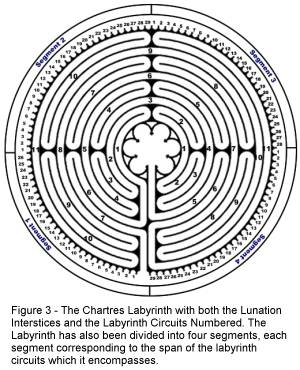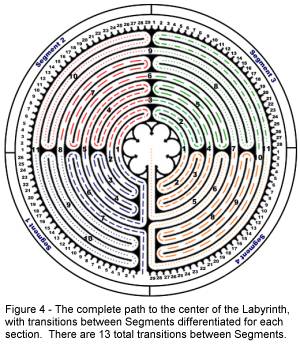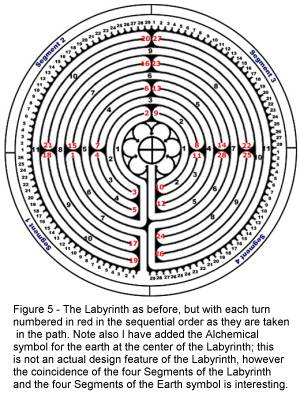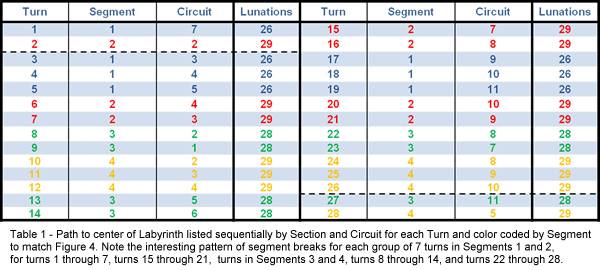|
“Thus it is no longer surprising that
Man, imitating his Creator, has at last found a method of singing in harmony
which was unknown to the ancients, so that he might play, that is to say, the
perpetuity of the whole of cosmic time in some brief fraction of an hour, by the
artificial concert of several voices, and taste up to a point the satisfaction
of God his Maker in His works by a most delightful sense of pleasure felt in
this imitator of God: Music.”
Johannes Kepler, Harmonices
Mundi[i]
The
Chartres Labyrinth holds a special interest for me. It is among other things,
the first full scale labyrinth which I personally circumambulated. I should more
correctly say that it was a full scale replica, and that it was located in a
Presbyterian Church near Columbus, Ohio (which is a long way from France). I
undertook this activity shortly after being raised as a MM and I remember at the
time being fascinated with the intricate, almost mathematical pattern of the
labyrinth. Following my experience, I began to research labyrinths in general
and the Labyrinth of Chartres in particular. This research revealed that walking
the Labyrinth is considered to be a symbolic journey from life to death[ii]
and that in medieval times walking the labyrinth was accepted as a surrogate for
a pilgrimage to the Holy Land[iii].
The Labyrinth is also believed to possibly be an ancient astronomical
device or calendar.
In
the course of my research I happened upon an article[iv]
prepared by Eminent Freemason Bro. Bruno Gazo, Editor of Pietre-Stones Review of
Freemasonry. This article deals with the concept of rhythm and unconscious
(emotive) thought processes. Having, in the course of my analysis of the
Labyrinth, discovered repetitive patterns embedded within the design, the
realization occurred that these patterns could well be described as rhythms.
Further reading[v]
indicated labyrinths are widely regarded to have rhythmic characteristics. This
paper discusses my examination of the rhythms of the Chartres Labyrinth and
provides the basis for my analysis of the Labyrinth and its rhythmic properties.
The
Labyrinth
During
medieval times there was a very close link between the Craft Masons and the
Knights Templar[vi].
The Templars sponsored the building of Cathedrals throughout Europe, and
it makes perfect sense that in so doing that they employed, and enjoyed a
cordial relationship with, large numbers of Craft Masons. One particular project
which was sponsored by the Templars was the building of the great Cathedral in
Chartres, France. This beautiful Gothic structure still stands, and is world
famous for its art and architecture, including a large Labyrinth which graces
the floor of the Cathedral nave. In
his excellent book, Masonic Symbols and Signposts[vii],
Bro. Leon Zeldis does a wonderful job discussing Labyrinths and their connection
to Freemasonry, and includes an excellent illustration showing the Chartres
Labyrinth.

The Chartres Labyrinth is a circular, stone mosaic construction[viii]
(See Figure 1). It is an eleven circuit unicursal (one way in and one way out)
design. The labyrinth is divided into four segments and the path to the center
contains twenty-eight turns (seven per section, fourteen per side). The
circumference of the labyrinth is bordered by 112 lunations, an average of
twenty-eight lunations per section[ix].
I say “average” because the lunations are not uniformly distributed. One
side of the labyrinth actually contains fifty-seven lunations, while the
diametrically opposite side contains fifty-five[x].
This difference creates an inequality in spacing of the lunations. This
inequality of spacing is not believed to be an anomaly but rather it figures
into certain elliptical features of the lunar orbit. Note that the number 28 (28
= 4 X 7) appears frequently here. Many researchers have commented upon the
calendar-like properties of the labyrinth. For example, the four segments
containing 28 lunations each (on average) could perhaps represent four, 28 day
long, months (after all a month averages four, seven day long weeks).

The
Chartres Labyrinth itself is unique in that it presents an initial appearance of
symmetry, with each segment and each half appearing to mirror the segment or
half directly opposite. In fact the design is pseudo-symmetrical[xi],
and each segment is unique. To illustrate this, I have traced the initial path
of the Labyrinth leading to its center in Figure 2. Note that there is no true
geometric symmetry in the design. Interestingly, the Chartres Labyrinth, though circular can
also be drawn in a square configuration[xii].
As a preliminary to analyzing the Labyrinth, In Figure
3 I have modified the original (Figure 1) by sequentially numbering the
interstices (spaces in between the spokes of the lunations) in each segment of
the labyrinth and by similarly numbering each of the eleven circuits.
During my discussions of the labyrinth these numbers will be points of
reference.

Figure
4 has been developed by tracing the path to the center of the labyrinth using a
system in which the path through each segment is represented by a different
color (segment 1 – blue, segment 2 – red, segment 3 – green, and segment 4
– orange). Additionally I have tracked the continuity of the path within each
segment using a series of dashed and dotted lines.
I have considered continuity here to be the unbroken path within each
segment bounded by the two points at which that path crosses from or into the
next segment. I have used a light dashed line for the initial path in each
segment, a bold dashed line for the second path, a dotted line for the third
path. One segment (segment 3) contains a fourth path which I have designated
using a combined dashed and dotted line.

Using a conventional twelve month calendar as a reference, each segment
of the labyrinth would represent a quarter, with each quarter consisting of
three months. Each of the three
continuous paths in a quarter (other than segment 3 which has 4 paths) would
therefore represent one month. While
the math may be right for this calendar-like scenario, it is obvious from Figure
4 that things are a bit more complicated than that. Specifically the paths do
not flow through the segments sequentially. A good example of this is path 4 in
Segment 2 (Figure 4), which clearly flows “backwards” to Segment 1 instead
of continuing to Segment 3 as a nice, well-behaved calendar might be expected to
do. Clearly the segments do not represent quarters of the year as we would
expect based upon modern calendar conventions.
Apparently the 13th Century understanding of linear calendar
time was different than the modern concept, or there is an alternative event
other than time being represented here (my attempts to determine a
correspondence between the Labyrinth and Planet retrograde motion have been
unsuccessful).

Figure
5 shows the labyrinth annotated so that each of the 28 turns in the labyrinth is
labeled relative to the segment and circuit in which it occurs. Table
1 provides the same information in tabular form where the display of the
resulting pattern is more obvious. In
this table I have specified a turn as occurring at the point at which it ascends
or descends to the next circuit. Additionally I have color coded the turns
according to the segment in which they occur using the same color system used
for the lines shown in Figure 4.
Table 1 demonstrates that the 28 total turns in the labyrinth are
completed in a pattern such that 7 turns in Segments 1 and 2 are addressed
first, then 7 turns in Segments 3 and 4, whereupon the final 7 turns in Segments
1 and 2 are completed, followed by the completion of the 7 turns in Segments 3
and 4. This pattern of path
completions mimics lateral (mirror image) symmetry. The path to the center is
reached by completing 4 paths from Segment 1, and 3 paths from Segment 2,
followed by the same completion pattern in Segments 3 and Segment 4. The pattern
moves to finish Segments 1 and 2 by the completion of the remaining 3 paths in
Segment 1 and the remaining 4 paths in Segment 2, before following an identical
pattern in the completion of Segments 3 and 4. In all cases the completion
pattern is 2 – 2 - 3, except for the first two and last two paths which are
sequential.

This seems quite
remarkable because without the uneven number of continuous paths resulting from
the extra (i.e. the fourth) continuous path in Segment 3 (Circuit 11) this
pattern would not be possible. Upon completing Table 1 it was evident that the
various paths in the labyrinth could be represented as continuous rhythm by
visualizing each path as a separate beat. This may be demonstrated by recording
these beats using musical notation. Since we have no indication that any of the
notes correspond to a specific tone (or pitch), we can treat them as a monotone
rhythm, and represent them musically using standard musical symbols. Figure 6
provides the musical notation which describes the Labyrinth’s complex rhythm.

For the benefit of non-musicians (I am one myself) I
would recommend that to enhance your understanding of musical notation you may
wish to visit the very informative website provided by Daniel Laberge[xiii], or the equally excellent website provided by
“Number A Productions”[xiv].
I will dive into the murky waters
of conjecture by offering the observation that each note in the rhythm of the
Labyrinth could be assigned a tone based upon its position (from one to eleven)
in the circuit in which it occurs. For example given nine normal positions for a
note on the staff, and with two additional notes on a ledger line (perhaps one
above and one below the staff) one might produce a harmony. A more detailed
mathematical analysis by persons familiar with harmonics would possibly result
in a different, but equally interesting interpretation. Rhythm
and harmony were very important to the Pythagoreans[xv] who believed that music and geometry were two of the
four forms of mathematics (Astronomy and Arithmetic being the other two –
together they form the Quadrivium[xvi]). Clearly the Pythagoreans understood the ability of
rhythm, which is the basis of music, to affect us in a spiritual context.
One aspect of the Labyrinth which I have not yet attempted to explore is
the connection between rhythm and dance. Dance has historical ties to the
Labyrinth of Chartres and many other Medieval Labyrinths[xvii]. The Chartres Labyrinth was reportedly
circumambulated by monks using a peculiar “bat wing” dance step. This may be
tied to the Crane Dance[xviii]
allegedly introduced by Theseus of Crete, and said to represent the course of
the sun. Theseus was of course famous for his Minotaur exploits in Greek
mythology. There are also possible ties to certain Minoan rites of Phaistos and
Knossos. I suspect that the many
changes in the directional progression of the Labyrinth may have some
ecclesiastical significance.
Conclusion
Visualize the rhythm of waves falling upon the seashore for just a
moment. I suspect that this simple audio visualization will have elicited in you
an overwhelming sense of tranquility. Visualize
the rhythm of the breath of someone you love as they lay sleeping. Rhythm has
the power to invoke emotions. Consider the atmosphere of a crowded dance floor
in which the dancers are moved to a frenzied pace- by rhythm. The universe is
filled with rhythm, from the rising and setting of the Sun to the seasons of the
year, to the beating of our own hearts. It’s no accident that Johannes Kepler[xix]
referred to “the music of the spheres” when contemplating planetary orbits
in “Harmonices Mundi” (The Science of the Harmony of the World).
I
have not yet discovered how or whether the Labyrinth of Chartres represents an
astronomical chart or a calendar of celestial events; however I know that these
events occur in a rhythmic sequence and that the rhythm of the Labyrinth may
very well prove to have celestial mechanics as its basis.
[i]
Kepler,
Johannes. Harmonices Mundi (The Science of the Harmony of the World, 1619).
Translated by Christopher White . Schiller Institute. http://www.schillerinstitute.org/transl/trans_kepler.html
[ii]
Hicks, Clive.The Way of the Labyrinth. Freemasonry Today. Issue 20, April
2002. Accessed July 12. 2007 http://www.freemasonrytoday.com/public/index-20.php
.
[iii]
Kern, Herman. Through the Labyrinth: Designs and Meanings over 5,000 Years.
Prestel Publishing; Ferre Robert edition (September 2000). ISBN-10:
3791321447 ISBN-13: 978-3791321448
[v]
Hebert, Jacques. The Rhythmical Structure of the Medieval Labyrinth. 2004.
Quebec. ISBN 2-9808090-0-4. http://www.labyreims.com/e-tablemat.html
[vi]
Wallace-Murphy, Tim. The Enigma of the Freemasons. Ivy Press. New York.
(2006)
ISBN-10:1-932857-44-3 ISBN-13:978-1-932857-44-3.
[vii]
Zeldis, Leon. Masonic Symbols and Signposts.
Anchor Communications LLC (February 10, 2003).
ISBN-10: 0935633278
ISBN-13: 978-0935633276
[viii]
Curl, James Stevens. The Art and Architecture of Freemasonry. Overlook Press.
1993. New York. ISBN 0879514949
[ix]
Mathews, W.H., Mazes and Labyrinths.Dover Publications; New Ed edition (June
1, 1970). ISBN-10:
048622614X
ISBN-13: 978-0486226149
[x]
Mccullough, David W. The Unending Mystery: A Journey Through Labyrinths and
Mazes. Anchor; Reprint edition (November 8, 2005). ISBN-10: 1400031648
ISBN-13: 978-1400031641
[xi]
Conty, Patrick. The Genesis and Geometry of the Labyrinth: Architecture,
Hidden Language, Myths, and Rituals. Inner
Traditions (December 1, 2002).
ISBN-10: 0892819227
ISBN-13: 978-0892819225.
[xii]
Jensen, Niels Mejlhede.
Chartres Labyrinth in Chartres: analysis of lane pattern. http://www.lavigne.dk/labyrinth/e6charst.htm
, http://www.lavigne.dk/labyrinth/e5chartr.htm
[xiii]
Laberge, Daniel. Rhythm Exercise 1-1.. Simple Note Figures and Ties. http://www.daniellaberge.net/music/rhythm/exercises/1-1.html
[xiv]
Hollis,Ben, Kate Bankson, and Chris GillottiThe Method Behind the Music.
Number A Productions. http://numbera.com/musictheory/theory/notation.aspx
[xv]
Calter, Paul. Pythagoras and Music of the Spheres. Dartmouth University http://www.dartmouth.edu/~matc/math5.geometry/unit3/unit3.html.
[xvi]
Ibid. Pythagoras and Music of the Spheres. Dartmouth University http://www.dartmouth.edu/~matc/math5.geometry/unit3/unit3.html.
[xvii]
Morrison, Tessa. School of Architecture and Built Environment, University of
Newcastle, Australia. from Peregrinations. http://peregrinations.kenyon.edu/vol1-3/morrison.pdf
[xviii]
Aleff, Peter H. Rediscovered Science.
http://www.recoveredscience.com/labyrinthclues3.htm
[xix]
The Music of The Spheres. Aramantha Publishing.
http://www.amaranthpublishing.com/kepler.htm
|
![]() News Feed |
News Feed |  Subscribe News by Email
Subscribe News by Email